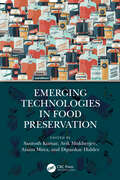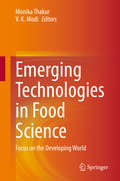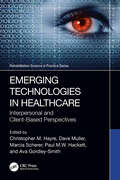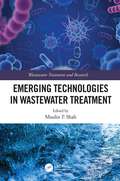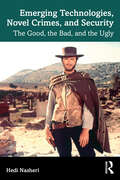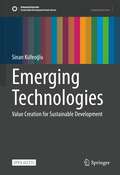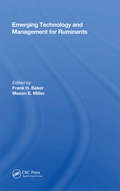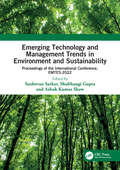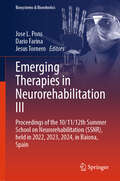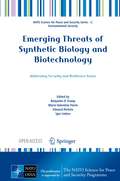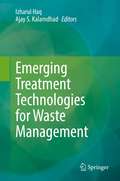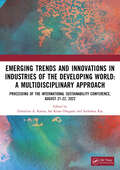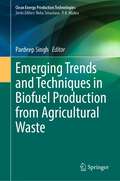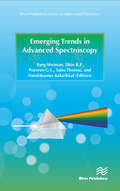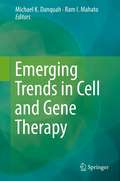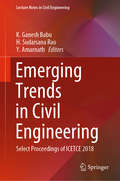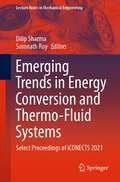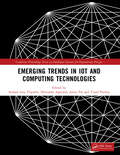- Table View
- List View
Emerging Technologies in Food Preservation
by Santosh Kumar Avik Mukherjee Atanu Mitra Dipankar HalderConsumers worldwide are becoming increasingly aware of the significant impacts of food quality, nutrition, and food habits on their health. Demands for fresh, minimally processed foods, foods subjected to less severe preservation and processing, and for foods with no synthetic chemical preservatives are expanding rapidly. Food businesses worldwide are innovating advanced processing and preservation technologies, including natural, bioactive preservatives to fulfill these emerging consumers’ demands. Emerging Technologies in Food Preservation discusses the innovations and advancements in food processing and preservation that have emerged over the last two decades of the 21st century. Various experts in the field examine different innovative food processing and preservation technologies, including non-thermal and minimal processing technologies, particularly those that have least destructive impact on micronutrients. Key Features: Describes the hurdles and challenges in commercialization of these novel processing technologies, including their legal ramifications on food regulations and legislations. Provides detail accounts of application of each of the novel food preservation principles, as they are applied in commercial food processing / food manufacturing lines worldwide. Features a complete account on recent developments and advancements in food preservation and processing technologies, including natural and biopreservatives Mindful of the increasing interest in alternatives to traditional thermal processing of foods and beverages, this book is a valuable reference for students, scholars, researchers, scientists, food entrepreneurs, as well as technical professionals working in food industries and associated businesses.
Emerging Technologies in Food Science: Focus on the Developing World
by Monika Thakur V. K. ModiThis book provides a comprehensive review of recent innovations in food science that are being used to tackle the challenges of food safety, nutritional security and sustainability. With a major focus on developing nations, like India, the book is divided into four main sections. The first section provides an overview of the food industry, while the second explores food safety in various segments, with an interesting account of street food safety – an important, yet often neglected aspect for safety parameters. The third section, on nutritional security and sustainability, explores various ways of maximizing nutrition and optimizing waste management in the food industry. The book closes with a section on emerging technologies and innovations, which introduces readers to some of the latest technologies in the food industry, including advances in food processing, packaging, nanotechnology, etc. The topics have been divided into 25 different chapters, which offer a diverse blend of perspectives on innovations in the developing world. Ideally suited for students and researchers in the food sciences, the book is also an interesting read for industry experts in Food Science and Technology.
Emerging Technologies in Healthcare: Interpersonal and Client Based Perspectives (Rehabilitation Science in Practice Series)
by Christopher M. Hayre, Dave Muller, Marcia Scherer, Paul M.W. Hackett, and Ava Gordley-SmithThis edited book focuses on the role and use of emerging technologies within the healthcare sector. This text draws on expertise from leading practitioners and researchers who either utilize and/or are at the forefront of researching with emerging technology in anticipation of enhancing patient outcomes.Emerging Technologies in Healthcare: Interpersonal and Client-Based Perspectives focuses on the role of emerging technologies in society and how it may enhance medical treatment, management, and rehabilitation of service users. It offers expert perspectives on topics covering emerging technological advances and how they are being incorporated into healthcare, but also critically appraises forthcoming implementation. The editors draw from recent publications and the growing narrative surrounding technological advances, notably telerehabilitation, virtual reality, augmentation, and mHealth. Subsequent chapters focus on these, coupled with other emerging technologies, providing detailed insight into how these can either enhance and/or hinder patient/service user outcomes. Each chapter explores the multifaceted use and application of each emerging technology, that impacts on diagnosis, treatment, and (self-) management of individuals. For example, can emerging technology really facilitate patient diagnosis, improve, or remove practitioner–patient interactions, provide sound rehabilitation, and treat/monitor mental health conditions?This edited volume encompasses an array of emerging technologies that will remain pertinent to caregivers, families, practitioners, service users and policymakers. This is not a text on emerging technology alone but on its societal implications, accompanied by ethical, altruistic, and moral examples for such advances within the healthcare field. It is targeted that this text will enhance and offer original discussions surrounding the interconnectivity of technology and medicine, rehabilitation, and patient care.
Emerging Technologies in Wastewater Treatment (Wastewater Treatment and Research)
by Maulin P. ShahEmerging technologies in wastewater treatment plant is an ecological, profitable and natural technology designed to eliminate heavy metals, radionuclides, xenobiotic compounds, organic waste, pesticides, etc. from contaminated sites or industrial downloads through biological means. Since this technology is used in conditions on site, it does not physically disturb the site unlike conventional methods, that is, chemical or mechanical methods. In this technology, higher plants or microbes are used alone or in combination for the phytoextraction of heavy metals from sites contaminated with metals. Through microbial interventions, metals are immobilized or mobilized through redox conversions in contaminated sites. If they are mobilized, accumulating metal plants are placed to accumulate metals in their bodies. Next, metal-loaded plants are collected and recycled to reduce the volume of waste and then, disposed of as hazardous materials or used for the recovery of precious metals, if possible. In case of immobilization, metals are no longer available to be toxic to organisms. There are very few books published on the proposed theme. A good number of books have been published on environmental bioremediation, but the proposed book is a new and an innovative proposal specifically in wastewater treatment. Looking into the importance of emerging technologies in wastewater treatment research, the book will have a high and applicable value in industrial wastewater treatment research. Features: The book highlights the importance of emerging technologies in the wastewater treatment plant to clean up the environment from pollution caused by human activities. It assesses the potential application of several existing bioremediation techniques and introduces new emerging technologies. It is an updated vision of the existing emerging technologies in environmental bioremediation strategies with their limitations and challenges and their potential application to remove environmental pollutants. It also introduces the new trends and advances in environmental bioremediation with a thorough discussion of recent developments in this field. Highlights the importance of bioremediation to deal with the ever-increasing number of environmental pollutants.
Emerging Technologies, Novel Crimes, and Security: The Good, the Bad, and the Ugly
by Hedi NasheriThis book provides a holistic overview of the complexities of modern technological advances and their implications for crime and security. It examines the societal dilemmas that accompany these technologies, their strategic impact on geopolitics, governments, business, and civil society.The increasingly interconnected world gives rise to novel crimes and creates a new, complex set of threats. Understanding this landscape is essential to strategizing for the prevention, protection, mitigation, and risk assessment of technology-related crime.Practical and approachable, this book builds knowledge and awareness of the impact of emerging technologies on crime and security among professionals, students, academicians, researchers, and policymakers.
Emerging Technologies: Value Creation for Sustainable Development (Sustainable Development Goals Series)
by Sinan KüfeoğluThis monograph investigates a multitude of emerging technologies including 3D printing, 5G, blockchain, and many more to assess their potential for use to further humanity’s shared goal of sustainable development. Through case studies detailing how these technologies are already being used at companies worldwide, author Sinan Küfeoğlu explores how emerging technologies can be used to enhance progress toward each of the seventeen United Nations Sustainable Development Goals and to guarantee economic growth even in the face of challenges such as climate change. To assemble this book, the author explored the business models of 650 companies in order to demonstrate how innovations can be converted into value to support sustainable development. To ensure practical application, only technologies currently on the market and in use actual companies were investigated. This volume will be of great use to academics, policymakers, innovators at the forefront of green business, and anyone else who is interested in novel and innovative business models and how they could help to achieve the Sustainable Development Goals. This is an open access book.
Emerging Technology And Management For Ruminants
by Frank H BakerThe Proceedings of the 1985 International Stockmen's School Seminars, Emerging Technology and Management for Ruminants, includes approximately fifty technical papers given at this year's Stockmen's School, sponsored by Winrock International. The authors are outstanding animal scientists, agribusiness leaders, and livestock producers w
Emerging Technology and Management Trends in Environment and Sustainability: Proceedings of the International Conference, EMTES-2022
by Sushovan Sarkar Shubhangi Gupta Ashok Kumar ShawThe International Conference (EMTES 2022) is oriented to include the themes like Water Quality Management, Advanced Water Treatment, Advanced Wastewater Treatment, Assessment and Control of Air Pollution, Solid and Hazardous Waste Management, Prevention of Groundwater Contamination, Wetland Management/Phyto-remediation, Case studies in Industrial Pollution Control, Liquid waste management, recent advancement in engineering, technology and management for optimization of environmental issues, application of IOT and IT in remedial measure of Environment and sustainability, Health issues and safety.
Emerging Therapies in Neurorehabilitation III: Proceedings of the 10/11/12th Summer School on Neurorehabilitation (SSNR), held in 2022, 2023, 2024, in Baiona, Spain (Biosystems & Biorobotics #34)
by Dario Farina Jose L. Pons Jesus TorneroThis book offers a timely snapshot of research of biomedical and neural engineering, and their applications in neurorehabilitation. It gathers peer-reviewed contributions to three different conference editions (of the series Summer School on Neurorehabilitation (SSNR)) , which were held in Baiona, Spain, on June 12–17, 2022, June 11–16, 2023, and June 16–21, 2024, respectively. They report on applications of cutting-edge neuroprosthetic devices, robotic interfaces, and related technologies to assist patients with neurologic and musculoskeletal conditions, such as stroke, spinal cord injury, and amputation, among others. A special feature consists of the fact that both technological and clinical issues are discussed, providing readers with a multidisciplinary perspective on neurorehabilitation research and practice.
Emerging Threats of Synthetic Biology and Biotechnology: Addressing Security and Resilience Issues (NATO Science for Peace and Security Series C: Environmental Security)
by Igor Linkov Benjamin D. Trump Marie-Valentine Florin Edward PerkinsSynthetic biology is a field of biotechnology that is rapidly growing in various applications, such as in medicine, environmental sustainability, and energy production. However these technologies also have unforeseen risks and applications to humans and the environment. This open access book presents discussions on risks and mitigation strategies for these technologies including biosecurity, or the potential of synthetic biology technologies and processes to be deliberately misused for nefarious purposes. The book presents strategies to prevent, mitigate, and recover from ‘dual-use concern’ biosecurity challenges that may be raised by individuals, rogue states, or non-state actors. Several key topics are explored including opportunities to develop more coherent and scalable approaches to govern biosecurity from a laboratory perspective up to the international scale and strategies to prevent potential health and environmental hazards posed by deliberate misuse of synthetic biology without stifling innovation. The book brings together the expertise of top scholars in synthetic biology and biotechnology risk assessment, management, and communication to discuss potential biosecurity governing strategies and offer perspectives for collaboration in oversight and future regulatory guidance.
Emerging Treatment Technologies for Waste Management
by Ajay S. Kalamdhad Izharul HaqThis book is focused on the current status of industrial pollution, its source, characteristics, and management through various advanced treatment technologies. The book covers the recycle, reuse and recovery of waste for the production of value-added products. The book explores industrial wastewater pollution and its treatment through various advanced technologies and also the source and characteristics of solid waste and its management for environmental safety. It discusses new methods and technologies to combat the waste-related pollution and focuses on the use of recycled products. This book is of value to upcoming students, researchers, scientists, industry persons and professionals in the field of environmental science and engineering, microbiology, biotechnology, toxicology, further it is useful for global and local authorities and policy makers responsible for the management of liquid and solid wastes.
Emerging Trends and Innovations in Industries of the Developing World: A Multidisciplinary Approach
by Sai Kiran Oruganti Sudeshna Ray Dimitrios A. KarrasISC 2022 is dedicated to the Niti Aayog policies to promote sustainability through exchange of ideas emerging out of the academia. The ISC is an annual conference that is held in virtual mode until COVID restrictions on travel exist. The vision of the conference is to capacitate Academia with the necessary ideas that provide insights of the grassroot level development to various stakeholders of the Niti-Aayog policies. Towards this goal, the conference creates a conjunction of various stakeholders of Niti-Aayog policies that include- academic institutions, government bodies, policy makers and industry. The ISC organizers make concerted efforts to promote academic research that would technological, scientific, management & business practices, and insights into policy merits & disruptions. The framework of exchange of ideas is geared towards adoption of deep technologies, fundamental sciences & engineering, energy research, energy policies, advances in medicine & related case studies. This framework enables the round table discussions between the academia, industry and policy makers through its range of plenary and keynote speakers.
Emerging Trends and Techniques in Biofuel Production from Agricultural Waste (Clean Energy Production Technologies)
by Pardeep SinghThis edited book focuses primarily on biofuel production potential in agricultural waste, such as biogas generation, biohydrogen production, and research trends on managing or converting agricultural waste to biofuel. This book also draws attention to technological equipment, generated biofuels from agricultural waste through various biological and chemical processes, and the multiple factors responsible for biofuels from agricultural waste generation. Agriculture waste can be a renewable source of lignocellulosic feedstock for value-added products. Considering the non-replaceable fossil fuel reservoir, the exponentially growing human population urges an immediate search for alternative renewable energies. To confront the upcoming energy crisis, lignocellulosic agricultural waste is expected to be a sustainable, renewable, low-cost resource to derive bioenergy because of its high availability. This book will be of interest to researchers, scientists, and scholars working on agriculture waste management and biogas production. The book also serves as additional reading material for Industrial professionals, master's and degree students, policymakers, and NGOs working on biofuels and sustainable energy production.
Emerging Trends in Advanced Spectroscopy (River Publishers Series In Optics And Photonics Ser.)
by Sabu Thomas Nandakumar Kalarikkal Jibin K. P. Yang Weiman Praveen G. L.Experimental studies carried out by a spectroscopic approach, and the techniques used for investigating the acquired information, can be given a robust modern analytical framework in the design of new materials, and for emphasis on the expansion of physical foundations of new materials. Emerging Trends in Advanced Spectroscopy may help to understand the applications of spectroscopic tools in material characterization. The text also shows how different spectroscopic methods are used by researchers worldwide, and how we can correlate the experimental observations with structural information.Technical topics discussed in the book include: Geometries, electronic structures and vibrational spectral studies Advanced spectroscopic techniques in polymer chemistry Spectroscopic portrayals of graphitic structures fluorescent metal nanoclusters as sensory probes for metal ions colorimetric chemo sensor Nano mixed ferrites and their applications to nanoelectronics Solid phase astrochemistry
Emerging Trends in Cell and Gene Therapy
by Ram I. Mahato Michael K. DanquahExamples from various organs and diseases illustrate the potential benefit obtained when both therapeutic approaches are combined with delivery strategies. Representing the combined effort of several leading international research and clinical experts, this book, Emerging Trends in Cell and Gene Therapy, provides a complete account on and brings into sharp focus current trends and state-of-the-art in important areas at the interface of cell- and gene-based therapies. This book addresses the current fragmented understanding regarding these two research areas and fills the vast unmet educational need and interest of both students and researchers in academia and industry. Main features of the book: · Biological aspects of stem cell sources, differentiation and engineering. · Application of microfluidics to study stem cell dynamics · Potential clinical application of stem cells and gene therapy to specific human disease. · Utilization of biomaterials and stem cells in regenerative medicine with particular emphasis on spinal cord repair, ligament and bone tissue engineering. · Biomimetic multiscale topography for cell alignment.
Emerging Trends in Civil Engineering: Select Proceedings of ICETCE 2018 (Lecture Notes in Civil Engineering #61)
by K. Ganesh Babu H. Sudarsana Rao Y. AmarnathThis book comprises select papers from the International Conference on Emerging Trends in Civil Engineering (ICETCE 2018). Latest research findings in different branches of civil engineering such as structural engineering, construction materials, geotechnical engineering, water resources engineering, environmental engineering, and transportation infrastructure are covered in this book. The book also gives an overview of emerging topics like smart materials and structures, green building technologies, and intelligent transportation system. The contents of this book will be beneficial for students, academicians, industrialists and researchers working in the field of civil engineering.
Emerging Trends in Electric Aviation: Proceedings of the International Symposium on Electric Aviation and Autonomous Systems 2022 (Sustainable Aviation)
by T. Hikmet Karakoc Alper Dalkiran Ali Haydar Ercan Tomislav Letnik Maršenka Marksel Ismail EkmekciThe International Symposium on Electric Aviation and Autonomous Systems is a multi-disciplinary conference that presents research in the fields of aerospace, autonomous, and piloted unmanned systems. The 2022 conference provided a platform offering insights on a broad range of current issues in aviation, including hybrid, electric, all-electric, and fuel cell aerial vehicles, electric generation, energy storage, propulsion technology, and new identification and detection systems that adapt to the latest technology standards. ISEAS allows researchers, scientists, engineers, practitioners, policymakers, and students to exchange information, present new technologies and developments, and discuss future direction, strategies, and priorities in aviation and sustainability.
Emerging Trends in Energy Conversion and Thermo-Fluid Systems: Select Proceedings of iCONECTS 2021 (Lecture Notes in Mechanical Engineering)
by Somnath Roy Dilip SharmaThis book presents select proceedings of the International Conference on Energy Conversion and Thermo-fluid Systems (i-CONECTS 2021). It covers the latest trends in the areas of energy conversion and thermofluid systems. The topics covered include enhanced heat transfer, multi-phase flows, power generation technologies, fluid-structure interaction, alternative fuels, micro- and-nano-scale heat and mass transfer, energy, emissions control technologies, etc. The book will be a valuable reference for the researchers and professionals interested in the energy conversion technologies and allied fields.
Emerging Trends in Environmental Biotechnology
by Sukanta Mondal Shivesh Pratap Singh Yogendra Kumar LahirThe environment is an all-encompassing component of the ecosystem of "Blue planet - the earth", made up of the hydrosphere, atmosphere and lithosphere. These three spheres have biotic and abiotic components which exhibit ecological homeostasis that provides the most appropriate survival chances for the members of biotic component and geochemical balance with abiotic components. This ecosystem is subjected to relatively harsh conditions, mostly created by the disastrous activities due to natural calamities and intentional and/or accidental anthropogenic activities. Biotechnology has become a potential tool to dissipate such environmental impacts because of the advancement it has undergone recently. Emerging Trends in Environmental Biotechnology is an outstanding collection of current research that integrates basic and advanced concepts of biotechnology such as genomics, proteomics, bioinformatics, sequencing, and imaging processes to improvise and protect the environment. This book is particularly attractive for scientists, researchers, students, educators and professionals in environmental science, agriculture, veterinary and biotechnology science. The book will enable them to solve the problems about sustainable development with the help of current innovative biotechnologies such as recombinant DNA technology and genetic engineering which have tremendous potential for impacting global food security, environmental health, human and animal health and overall livelihood of mankind. Features Presents easy-to-read chapters Information is presented in a very accessible and logical format Identifies and explores biotechnological approaches for environmental protection Encompasses biodegradation of hazardous contaminants, biotechnology in waste management, nanotechnology, and issues in environmental biotechnology research
Emerging Trends in IoT and Computing Technologies: Proceedings of the International Conference on Emerging Trends in IoT and Computing Technologies-2023 (Conference Proceedings Series on Intelligent Systems for Engineering Designs)
by Suman Lata Tripathi Devendra Agarwal Anita Pal Yusuf PerwejSecond International Conference on Emerging Trends in IOT and Computing Technologies (ICEICT – 2023) is organised with a vision to address the various issues to promote the creation of intelligent solution for the future. It is expected that researchers will bring new prospects for collaboration across disciplines and gain ideas facilitating novel concepts. Second International Conference of Emerging Trends in IoT and Computer Technologies (ICEICT-2023) is an inventive event organised in Goel Institute of Technology and Management, Lucknow, India, with motive to make available an open International forum for the researches, academicians, technocrats, scientist, engineers, industrialist and students around the globe to exchange their innovations and share the research outcomes which may lead the young researchers, academicians and industrialist to contribute to the global society. The conference ICEICT- 2023 is being organised at Goel Institute of Technology and Management, Lucknow, Uttar Pradesh, during 12-13 January 2024. It will feature world-class keynote speakers, special sessions, along with the regular/oral paper presentations. The conference welcomes paper submissions from researcher, practitioners, academicians and students will cover numerous tracks in the field of Computer Science and Engineering and associated research areas.
Emerging Trends in Leather Science and Technology
by Sreeram Kalarical Janardhanan Luis A. ZugnoLeather and its products are globally traded commodities known for durability, fashion, reuse, repurpose, and resistance to degradation. Despite its benefits, the leather industry faces criticism from Non-Governmental Organizations (NGOs) due to its adverse environmental impact and often unfavourable labor conditions in non-certified tanneries. Efforts to enhance sustainability continue, yet challenges persist, prompting calls for revamping leather processing methods to ensure the industry's future compliance requirements. This monograph, through its 17 chapters, aims to address the multifaceted challenges and opportunities within the leather manufacturing industry, encompassing leather processing, product creation, and policy frameworks. The monograph includes contributions made by researchers, scientists, government officials, industry stakeholders, policymakers, and practitioners from more than 10 countries. It underscores the necessity for developing nations to grasp, address, and enhance their processing and manufacturing infrastructure including labor practices as well as meet export standards, to attain sustainability and compliance. Moreover, the book delves into formulating robust policies governing the leather processing and product sector, emphasizing the need for stringent regulations to mitigate adverse environmental impacts. By offering insights into smart and sustainable leather and leather product manufacturing practices, the book serves as a valuable resource for leather professionals and other stakeholders
Emerging Trends in Mechanical Engineering: Select Proceedings of ICETME 2018 (Lecture Notes in Mechanical Engineering)
by L. Vijayaraghavan K. Hemachandra Reddy S. M. Jameel BashaThis book comprises select proceedings of the International Conference on Emerging Trends in Mechanical Engineering (ICETME 2018). The book covers various topics of mechanical engineering like computational fluid dynamics, heat transfer, machine dynamics, tribology, and composite materials. In addition, relevant studies in the allied fields of manufacturing, industrial and production engineering are also covered. The applications of latest tools and techniques in the context of mechanical engineering problems are discussed in this book. The contents of this book will be useful for students, researchers as well as industry professionals.
Emerging Trends in Mechanical Engineering: Select Proceedings of ICETMIE 2019 (Lecture Notes in Mechanical Engineering)
by Naveen Kumar L. M. Das Rohit Singh Lather Pramod BhatiaThis book consists of select proceedings of the International Conference on Emerging Trends in Mechanical and Industrial Engineering (ICETMIE) 2019. It covers current trends in thermal, design, industrial, production and other sub-disciplines of mechanical engineering. This volume focuses on different areas of design engineering including computational mechanics, computational fluid dynamics, finite elements in modelling, simulation, analysis and design, kinematics and dynamics of rigid bodies, micro- and nano-mechanics, solid mechanics and structural mechanics, vibration and acoustics, applied mechanics, and biomechanics. It also covers various topics from thermal engineering including refrigeration plants, heat exchangers, heat pumps and heat pipes, combined heat and power and advanced alternative cycles, polygeneration, combustion processes, heat transfer, solar cells, solar thermal power plants, and the integration of renewable energy with conventional processes. This book will be useful for students, researchers as well as professionals working in the area of mechanical engineering, especially thermal engineering and engineering design and other allied areas.
Emerging Trends in Microbial Electrochemical Technologies for Sustainable Mitigation of Water Resources Contamination: Microbial Electrochemical Technologies in Wastewater Treatment
by Joyabrata Mal Rangabhashiyam Selvasembian Dakeshwar Kumar Verma Sovik Das Ioannis AnastopoulosThe book aims to highlight the application of microbial electrochemical technologies, their fundamental to advanced, recent applications, management strategies, and relevant case studies. The book also attempts to highlight existing research and technological advancements on all facets of instruments and methods for assessing and keeping track of water contaminants. The section on current trends and advancements in this book discusses the most recent advancements in microbial electrochemical technologies and related technologies to lessen the contamination of water resources. The book goes into great detail about the fundamental aspects of water pollution, including their causes, primary sources, detection, treatment, and mitigation using microbial electrochemical technologies and management systems as well as commercialization and economics thoughts that are currently of significant importance. Additionally, with the aid of appropriate tables and figures, all of these chapters havebeen arranged according to recent developments and aspects of the field. The book's goal is to give readers a fundamental understanding of how microbial electrochemical technologies work. It is intended for a wide range of readers, including undergraduate and graduate students, researchers, academicians, environmentalists, policymakers, businesspeople, and R&D teams. We gratefully thank all of the authors. We'll be open to recommendations for making the next book or edition better.
Emerging Trends in Nanomedicine
by Sanjay SinghThis book illustrates the significance of nanotechnology in the delivery of anticancer and antimicrobial drugs, biomimetic technologies, tissue engineering, sensing, diagnostics, and artificial enzymes. It first briefly discusses the use of nanotechnology for the delivery of anticancer medications, and the concept and applications of catalytically active nanomaterial-based artificial enzymes for sensing and diagnostic applications. It then explores the use of silver nanoparticle-based novel antimicrobials, and comprehensively reviews the role of nanomaterials in developing biomedical implants and tissue engineering applications. Lastly, it offers a detailed description of nanotherapeutics for combating human protozoan parasitic infections. Cutting across the disciplines, this book serves as a guide for researchers and scientists in biotechnology, medical science and material science.
